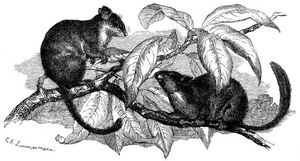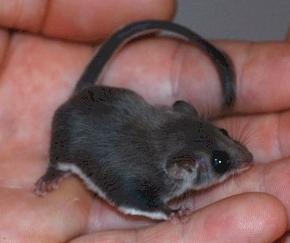Feathertail glider facts for kids
Quick facts for kids Feathertail glider |
|
|---|---|
 |
|
| Conservation status | |
| Scientific classification | |
| Kingdom: | |
| Class: | |
| Infraclass: | |
| Order: | |
| Suborder: |
Phalangerida
|
| Family: |
Acrobatidae
|
| Genus: |
Acrobates
Desmarest, 1818
|
| Binomial name | |
| Acrobates pygmaeus Shaw, 1793
|
|
The feathertail glider (Acrobates pygmaeus), also known as the pygmy gliding possum, pygmy glider or flying mouse, is the world's smallest gliding mammal. It is named after its long feather-shaped tail. Although only the size of a very small mouse (65 to 80 mm and 10 to 14 g), it can leap and glide long distances from tree to tree, up to 25 metres. Like other gliding mammals, the feathertail glider has a skin membrane between the fore and hind legs; thicker than that of the other marsupials like the sugar glider, but smaller in proportion, extending only between the elbows and knees.
Description
At just 6.5 to 8 cm (2.6 to 3.1 in) in head-and-body length and weighing about 12 g (0.42 oz), the feathertail glider is only around the size of a small mouse, and is the world's smallest gliding mammal. The fur is soft and silky, and is a uniform greyish brown on the upper body, and white on the underside. There are rings of dark fur around the eyes, the rhinarium is hairless and deeply cleft, and the ears are moderately large and rounded. The glider also has an unusually large number of whiskers, sprouting from the snout and cheeks, and from the base of each ear.
Like other gliding mammals, the feathertail glider has a patagium stretching between the fore and hind legs. Only reaching the elbows and knees, this is smaller than that of the petaurid gliding possums, although the presence of a fringe of long hairs increases its effective area. The tail is about the same length as the head and body combined, oval in cross-section, only slightly prehensile, and has very short fur except for two distinctive rows of long, stiff hairs on either side. This gives the tail the appearance of a feather or a double-sided comb. The hindfeet possess enlarged, opposable first digits, which unlike all the other toes on both fore and hind feet, lack claws.
The tongue is long and thin, reaching as much as 11 mm (0.43 in), and has numerous long papillae that give it a brush-like appearance. This improves the animal's ability to collect pollen and consume semi-liquid food. The structure of the ear is also unusual, since the animal possesses a unique bony disc with a narrow crescent-shaped slit just in front of the eardrum. The function of this bone is unclear, but it may act as a Helmholtz resonator and enhance sensitivity to certain frequencies of sound. The brain has been recorded as weighing 360 milligrams (0.013 oz).
The pouch opens towards the front, as is common in diprotodont marsupials, and contains four teats.
Distribution and habitat
Feathertail gliders are found across the eastern seaboard of continental Australia, from northern Queensland to Victoria and extreme south-eastern South Australia. There are no recognised subspecies. They inhabit a wide range of forest types across the region, from sea level to at least 1,200 m (3,900 ft) Fossils belonging to the genus Acrobates have been identified from deposits in Queensland dating back to 0.5 million years ago, during the late Pleistocene.
Images for kids
See also
 In Spanish: Pósum pigmeo acróbata para niños
In Spanish: Pósum pigmeo acróbata para niños




